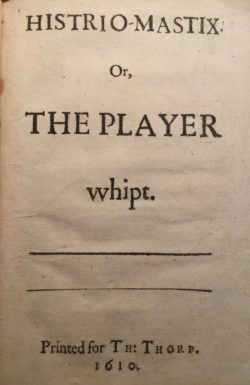<em>Histriomastix</em>
Histriomastix presents quite a challenge to the editor, not least because it has never been given the benefit of modern textual scholarship, and indeed has not appeared in print since 1939, when it was included in H. Harvey Wood’s old-spelling edition. Wood made a few minor emendations but otherwise provided what was essentially a diplomatic transcript of the original, without commentary or textual introduction. When it comes to establishing a reliable (and readable) modern text and explicating the play’s wealth of contemporary reference, Histriomastix is virgin territory. It is also unusually challenging because of uncertainties about its authorship and date of composition; about its alleged origins in amateur legal circles and its later role in the so-called War of the Theatres; and about how it came to be printed in 1610, and what relationship that text (the only one to have survived) has to the play that was performed in the 1590s.
Histriomastix employs a morality play framework extending (unusually) over six acts, and dramatises a cyclical view of history in which a commonwealth passes through periods dominated by Peace, Plenty, Pride, Envy, War, and Poverty, each stage generated by the one preceding, until Peace is finally restored. As a stay against this inexorable process, one of the leading characters affirms the central importance of law and beyond that, the importance of the liberal arts and their practitioners to the well-being of the commonwealth. The latter is emphatically not well served by the subplot featuring a group of working men who form themselves into a company of actors and are invited to play before an audience of aristocrats, with disastrous results. The play’s title, roughly translated in the subtitle, ‘The Player Whipped’, sums up the fate of the would-be actors, whose lively scenes form a diverting counterpoint to the formal allegory of the main action.
No author is credited on the title page of the 1610 edition; Marston is generally regarded as responsible for at least part of the play, though the circumstances of his participation, and the extent of it, have been hotly disputed in recent decades. Claims that Marston revised an old play from the 1580s for the Inns of Court jostle with the theory that he truncated his own original drama for performance by one of the boys’ companies at the turn of the seventeenth century. At present, very little can be said with certainty about how this play came into being or its role in the theatrical culture of late Elizabethan and Jacobean London, and it will be one of the tasks of this edition to test the hypotheses that have developed around the play in the light of a full annotation of its textual material and a more detailed appraisal of its theatrical nature and contexts.

